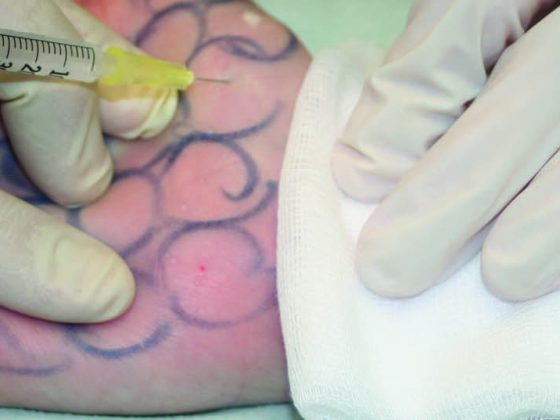For the correction of a funnel chest, open surgery according to Ravitch was performed in particular in earlier years. Currently, the minimally invasive correction according to Nuss (MIRPE) is preferred in many places. A non-invasive alternative or supplement is vacuum therapy using a suction cup, which has been offered in Basel since 2003.
Funnel chest (pectus excavatum [PE]) is a congenital malformation of the anterior chest. With an incidence of approximately 1:400 live births, PE is one of the most common congenital malformations. Boys are five to six times more likely to be affected than girls. In addition, there is a family history of the disease, suggesting a genetic cause.
In about 85% of affected children, the malformation is already visible at birth. In most cases, the malformation increases in the course of length growth, especially during puberty, and leads to a pathological posture. In addition to the thoracic wall deformity, adolescents in particular additionally show a malposition of the spine in the sense of a kyphosis, often in combination with a scoliosis. In some patients, the anterior thoracic wall is asymmetric and the sternum is tilted.
Young children subjectively rarely feel restricted due to their PE and are generally physically normal for their age. In adolescence, however, symptoms such as reduced physical resilience, impaired performance (especially in endurance sports), shortness of breath, heart problems, etc. may develop.
For some patients, PE also represents a strong psychological burden. The majority of affected patients feel significantly impaired in their physical well-being. Participation in sports, especially swimming, as well as other social activities are specifically avoided. Possible consequence is social isolation up to complete loneliness. In individual cases, there is even an increased risk of suicide.
Surgical treatment techniques
For a long time, open surgery according to Ravitch with resection of the medial rib ends and, if necessary, osteotomy of the sternum was considered the generally accepted standard procedure for the correction of PE. As an externally clearly visible sign of this procedure, a long scar usually remained, which some patients found aesthetically very disturbing. In 1998, Donald Nuss first described a novel, minimally invasive surgical technique in which a metal clamp is implanted under the sternum through small, lateral skin incisions [1]. This individually shaped bracket lifts the sternum and can thus correct the funnel from the inside. In more than 95% of cases, a good to excellent correction result can be achieved, which persists even after removal of the bracket [2]. The procedure is now widely used as a standard therapy for surgical correction of PE in many pediatric surgical centers [2, 3].
However, although “minimally invasive,” some risks, some significant, have been demonstrated with increasing duration of use [2–6]. These complications, the sometimes only very slightly pronounced local findings, the reluctance of some patients to undergo surgery, the fear of the postoperative pain phase as well as of a cosmetically unsatisfactory postoperative result have aroused interest in a newly developed, conservative procedure – vacuum therapy using a suction cup. The method itself was described more than 100 years ago [7]. Currently, this treatment method was revived in 2002 by Mr. E. Klobe from Mannheim. Initial experience reports [8, 9] have met with great interest, especially among affected patients.
The suction bell (after E. Klobe)
The suction cup is placed directly on the chest. A vacuum of approx. 15% below atmospheric pressure is generated by means of a hand pump. A clearly visible elevation of the sternum and ribs immediately after the bell was placed could be documented in the chest CT [8] as well as intraoperatively during MIRPE surgery [10]. The daily application time should be at least twice 30 minutes, but can be increased individually up to several hours daily.
Taking into account the individual patient age, three different sizes are currently available (Fig. 1) as well as an additional model for adolescent and adult female patients and a medium size model with special wall thickness.

Fig. 1: Suction bell models (16, 19 and 26 cm diameter)
During an initial outpatient consultation, the procedure itself is demonstrated, ultimately selecting the optimal model for each patient. The treatment should initially be started under medical supervision, but then be carried out by the patients themselves.
Relevant side effects have not been observed so far. Petechial hemorrhage, local hematoma, and back pain have occasionally been observed. However, these side effects are temporary and usually disappear with appropriate adjustment of daily use. Pain medication to perform regular use should not be required. However, the procedure should not be used in patients with skeletal disorders, heart disease, Marfan syndrome, and coagulopathies.
In 2003, the procedure was introduced at the Department of Pediatric Surgery of the University Children’s Hospital of Basel (UKBB). Since then, nearly 250 users have started the therapy. The results achieved so far show an impressive success. However, no conclusive statement can be made at present on long-term results over more than ten years after completion of treatment and on the question of the duration of treatment required in each case.
Patient selection
In our special consultation for thoracic wall deformities, we see patients on referral from the treating primary care physicians and, increasingly, on the own initiative of the affected patients.
Treatment with the suction cup can be performed practically at any age. Anamnesis and clinical examination form the basis of every clarification. Patients or their parents must be specifically asked about skeletal and cardiac diseases, coagulopathies, and symptoms that may indicate Marfan syndrome.
The depth of the funnel is measured in the supine position in mid-expiration at the deepest point. If PE requiring treatment is present, vacuum therapy is demonstrated and applied once during the consultation. At the same time, the appropriate bell size is also selected. Before starting regular use, a cardiological assessment (ECG, ultrasound) must be performed to exclude the above contraindications. Clinical follow-up visits are scheduled at three to six month intervals.
Preliminary results
A recently completed dissertation retrospectively analyzed data from 140 patients (28 female, 112 male) aged three to 62 years [11]. The average application time per day was 107.9 (10-480 minutes/day). The duration of therapy of the studied patient collective was 21.8 months (6 to 69 months). Follow-up after successful completion of therapy was 27.6 months.
Approximately 10% of users discontinued treatment after an average of 15.7 months. Declining motivation and unsatisfactory therapy success were the main reasons. Presenting the results in detail is beyond the scope of this overview. Figures 2-5 summarize some case studies.



Fig. 2: 7 year old patient a) before start (depth of PE: 1.1 cm), b) after nine months (depth of PE: 0.6 cm) and c) after 16 months (depth of PE: 0.2 cm)



Fig. 3: 15-year-old patient a) before start (depth of PE: 4.1 cm), b) after six months (depth of PE: 2.1 cm) and c) after eleven months (depth of PE: 1.6 cm)


Fig. 4: 11 year old patient a) before the start (depth of the PE: 2 cm) and b) after twelve months (depth of PE: 0.7 cm)


Fig. 5: 16-year-old patient a) before the start (depth of the PE: 4.5 cm) and b) after ten months (depth of PE: 2 cm)
Discussion
With the availability of modern information technologies, nowadays patients and pocentical users are sometimes better and faster informed than the treating physicians. In particular, patients who, for a wide variety of reasons, were rather averse to the previously known surgical procedures are increasingly interested in conservative vacuum therapy. Even though no usable data on long-term results are available yet, the present results are quite encouraging. Crucial to the success of a treatment procedure is careful and critical patient selection.
The application of the suction cup was found to be unproblematic in children as well as in adolescent and adult users. As shown previously [8], the suction cup develops significant forces and can deform the thoracic wall within a short time. Therefore, use in children under ten years of age should only be done under adult supervision. For motivation, it is important not to experience any restrictions in the personal daily routine as a result of the application (e.g. having to get up earlier in the morning). Patients with low-grade and symmetric PE often showed a better outcome than those with deep and/or asymmetric PE in the present study.
The question of treatment costs is currently unresolved. The suction cup is currently not recognized as a so-called medical aid. Pointing to this fact, most payers refuse to cover the cost of treatment.
CONCLUSION FOR PRACTICE
- Conservative vacuum therapy using a suction cup according to Klobe is an essential addition in the treatment of PE.
- The acceptance of the procedure by patients is very high.
- Selected patients, especially those with symmetric and mild PE, can be spared surgical correction of PE with this method.
- However, the extent to which this therapy represents a real alternative to surgery remains to be proven by treatment results. Long-term results and studies on larger patient groups are still lacking.
PD Dr. med. Frank-Martin Häcker
Literature:
- Nuss D, et al: A 10-Year Review of a Minimally Invasive Technique for the Correction of Pectus Excavatum. J Pediatr Surg 1998; 33: 545-552.
- Kelly RE, et al: Twenty-One Years of Experience With Minimally Invasive Repair of Pectus Excavatum by the Nuss Procedure in 1215 Patients. Ann Surg 2010; 252: 1072-1081.
- Häcker F-M, et al: Minimally Invasive Repair of Pectus Excavatum (MIRPE): The Basel Experience. Swiss Surgery 2003; 9: 289-295.
- Barsness K, et al: Delayed near-fatal hemorrhage after Nuss bar displacement. J Pediatr Surg 2005; 40: e5-e6.
- Adam LA, et al: Erosion of the Nuss bar into the internal mammary artery 4 months after minimally invasive repair of pectus excavatum. J Pediatr Surg 2008; 43: 394-397.
- Häcker F-M, et al: Near-fatal bleeding after transmyocardial ventricular lesion during removal of the pectus bar after the Nuss procedure. J Thorac Cardiovasc Surg 2009; 138 (5): 1240-1241.
- Long F. Thoracic deformities. In: Pfaundler M, Schlossmann A (editors): Handbook of Pediatrics, Vol V. Surgery and Orthopedics in Childhood. Leipzig, FCW Vogel 1910: 157.
- Schier F, et al: The vacuum chest wall lifter: an innovative, nonsurgical addition to the management of pectus excavatum. J Pediatr Surg 2005; 40: 496-500.
- Häcker F-M, et al: The vacuum bell for treatment of pectus excavatum: an alternative to surgical correction? Eur J Cardiothorac Surg 2006; 29: 557-561.
- Häcker F-M, et al: Intraoperative Use of the Vacuum Bell for Elevating the Sternum during the Nuss Procedure. J Laparoendosc Adv Surg Tech A. 2012; 22(9): 934-936.
- Zuppinger JN: The conservative therapy of funnel chest with the suction cup according to E. Klobe in children, adolescents and adults. Inaugural Dissertation for the Degree of Doctor of All Medicine, submitted to the Medical Faculty of the University of Basel 2013.











